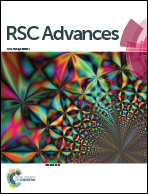Lewis acid free synthesis of 3,4-dihydro-1H-indazolo[1,2-b]phthalazine-1,6,11(2H,13H)-triones promoted by 1,1,1,3,3,3-hexafluoro-2-propanol
Abstract
A convenient, environmentally friendly and efficient procedure for the synthesis 3,4-dihydro-1H-indazolo[1,2-b]phthalazine-1,6,11(2H,13H)-trione derivatives has been developed via multi-component and one-pot reactions of various aldehydes with cyclic 1,3-diketones and phthalhydrazide 1,1,1,3,3,3-hexafluoro-2-propanol (HFIP). In simple and mild reaction conditions, the use of HFIP is explored as an easy workup and a green catalyst for the one-pot three-component synthesis of 3,4-dihydro-1H-indazolo[1,2-b]phthalazine-1,6,11(2H,13H)-triones. Thus, this practical method is developed as a notable medium for these derivatives via a multicomponent reaction.
![Graphical abstract: Lewis acid free synthesis of 3,4-dihydro-1H-indazolo[1,2-b]phthalazine-1,6,11(2H,13H)-triones promoted by 1,1,1,3,3,3-hexafluoro-2-propanol](/en/Image/Get?imageInfo.ImageType=GA&imageInfo.ImageIdentifier.ManuscriptID=C4RA06768A&imageInfo.ImageIdentifier.Year=2014)

 Please wait while we load your content...
Please wait while we load your content...